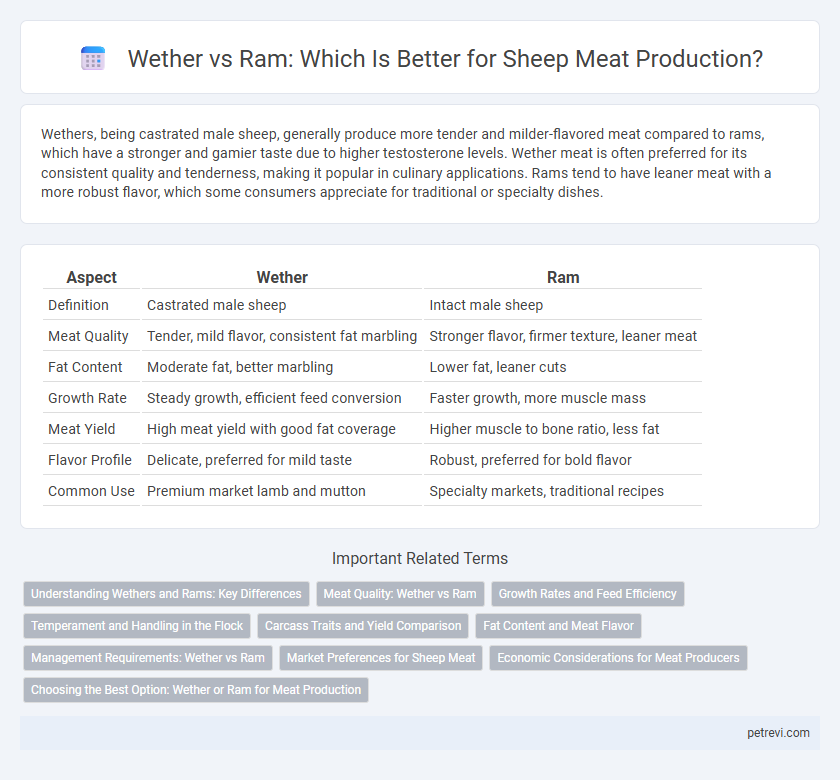Wethers, being castrated male sheep, generally produce more tender and milder-flavored meat compared to rams, which have a stronger and gamier taste due to higher testosterone levels. Wether meat is often preferred for its consistent quality and tenderness, making it popular in culinary applications. Rams tend to have leaner meat with a more robust flavor, which some consumers appreciate for traditional or specialty dishes.
Table of Comparison
| Aspect | Wether | Ram |
|---|---|---|
| Definition | Castrated male sheep | Intact male sheep |
| Meat Quality | Tender, mild flavor, consistent fat marbling | Stronger flavor, firmer texture, leaner meat |
| Fat Content | Moderate fat, better marbling | Lower fat, leaner cuts |
| Growth Rate | Steady growth, efficient feed conversion | Faster growth, more muscle mass |
| Meat Yield | High meat yield with good fat coverage | Higher muscle to bone ratio, less fat |
| Flavor Profile | Delicate, preferred for mild taste | Robust, preferred for bold flavor |
| Common Use | Premium market lamb and mutton | Specialty markets, traditional recipes |
Understanding Wethers and Rams: Key Differences
Wethers are castrated male sheep primarily raised for meat production due to their consistent growth rates and milder flavor compared to rams. Rams, intact males, typically have leaner meat with a stronger, gamier taste influenced by higher testosterone levels and can be less tender. Understanding the physiological and behavioral differences between wethers and rams helps farmers optimize meat quality and manage flock dynamics effectively.
Meat Quality: Wether vs Ram
Wether meat generally offers superior tenderness and a milder flavor profile compared to ram meat, making it more desirable for culinary uses. Rams tend to have a stronger, gamier taste and tougher texture due to higher testosterone levels influencing muscle composition. Meat quality from wethers typically shows better marbling and fat distribution, contributing to juiciness and overall eating experience.
Growth Rates and Feed Efficiency
Wether sheep typically exhibit faster growth rates and improved feed efficiency compared to rams, making them favorable for meat production. Rams tend to require more feed intake due to their larger frame and aggressive behavior, which can reduce overall feed conversion ratios. Selecting wether lambs can enhance profitability by maximizing daily weight gain while minimizing feed costs.
Temperament and Handling in the Flock
Wethers typically exhibit a calmer temperament than rams, making them easier to handle within the flock, especially during routine management and shearing. Rams, known for their more aggressive and territorial behavior, require experienced handlers to manage safely, particularly during breeding seasons when their instincts intensify. Managing sheep meat production benefits from choosing wethers when ease of handling and flock harmony are priorities.
Carcass Traits and Yield Comparison
Wether sheep, castrated males, tend to produce carcasses with more consistent fat distribution and higher dressing percentages compared to rams, which can exhibit leaner carcasses with more variable fat cover. Rams generally have greater muscle mass and yield heavier carcasses due to their intact hormonal status, but this can result in tougher meat and lower tenderness scores. Carcass traits such as marbling, fat depth, and feed efficiency often favor wethers for producing premium-quality lamb meat, though rams may offer advantages in total yield and growth rates.
Fat Content and Meat Flavor
Wether sheep, castrated males, tend to have higher intramuscular fat content compared to rams, resulting in more tender and flavorful meat. Ram meat often has a leaner profile with a stronger, gamier taste due to higher testosterone levels, which also influence muscle composition. Producers seeking mild-flavored, marbled meat typically prefer wethers, while rams are favored for leaner cuts with a robust flavor profile.
Management Requirements: Wether vs Ram
Wether sheep require less intensive management than rams due to their castrated status, which reduces aggressive behavior and eliminates breeding-related issues, simplifying handling and pasture management. Rams demand careful management to prevent fighting during the breeding season, including separate housing and increased supervision to avoid injuries. Nutritional needs for rams are higher to support reproductive activities, whereas wethers' diets focus primarily on growth and maintenance, allowing for more straightforward feeding regimens.
Market Preferences for Sheep Meat
Market preferences for sheep meat often favor wethers due to their consistent fat distribution and milder flavor, which enhances meat tenderness and consumer appeal. Rams typically have leaner meat with a stronger, gamier taste that can be less desirable in commercial markets focused on mild-flavored lamb and mutton. Consumer demand and processing qualities drive the preference for wether meat, making it more competitive in retail and restaurant sectors.
Economic Considerations for Meat Producers
Wethers often provide a more consistent carcass yield and leaner meat, making them economically advantageous for producers aiming to meet specific market demands. Rams typically exhibit faster growth rates and larger muscle mass, which can translate into higher overall meat production but may require more feed and management costs. Meat producers must weigh the balance between feed efficiency, growth rate, and market preferences when choosing between wether and ram lambs for optimal economic returns.
Choosing the Best Option: Wether or Ram for Meat Production
Wethers are castrated male sheep that typically produce more tender and milder-flavored meat due to reduced testosterone levels, while rams offer leaner cuts with a stronger, gamier taste. For consistent meat quality and ease of management, wethers are often preferred by producers focused on premium lamb sales. However, rams can provide valuable breeding benefits alongside meat production in integrated farming systems.
Wether vs Ram for Sheep Meat Infographic

 petrevi.com
petrevi.com